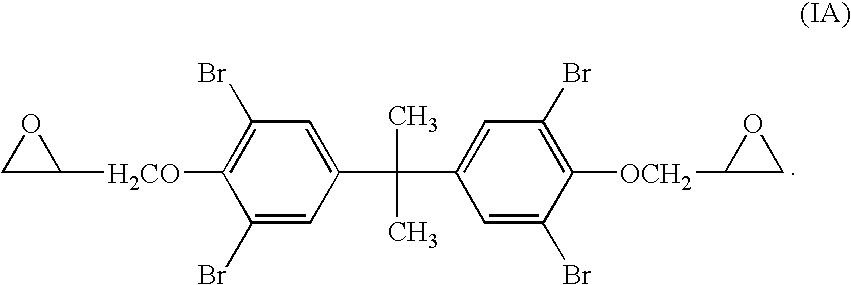Epoxy resin varnishes, laminates and printed circuit boards
- Summary
- Abstract
- Description
- Claims
- Application Information
AI Technical Summary
Benefits of technology
Problems solved by technology
Method used
Image
Examples
example 1
[0099]Example 1 was prepared by mixing 100 grams of epoxy resin XU 19074, grams of phenolic novolac KPH-L2003, 0.5 grams of 2-methyl imidazole and 5 grams of PM glycol ether. The properties of Example 1 were measured according to IPC-TM-650 tests listed in Table 2. The test results are shown in Table 2.
TABLE 2PropertiesTesting MethodResultPeel strength (1 oz)IPC-TM-650 2.4.86.1 lb / inDecomposition temperature (Td), TGAIPC-TM-650 2.4.24.6328° C.Young's ModulusIPC-TM-650 2.4.18.323.0 GPaWater absorptionIPC-TM-650 2.6.2.10.18%Volume resistivityAfter moistureIPC-TM-650 2.5.17.15 × 108 MΩ-cmE-24 / 1252 × 107 MΩ-cmSurface resistivityAfter moistureIPC-TM-650 2.5.17.15 × 107 MΩE-24 / 1254 × 106 MΩDielectric constant (Dk)250 MHzIPC-TM-650 2.5.5.24.60IPC-TM-650 2.5.5.3IPC-TM-650 2.5.5.9Thermal stress10 sec at 288° C.IPC-TM-650 2.4.13.12310 sec at 320° C.IPC-TM-650 2.4.13.110ModifiedFlammability testingUL94V0
example 2
[0100]Example 2 was prepared by mixing 100 grams of epoxy resin XU 19074, grams of phenolic novolac KPH-L2003, about 15 grams to about 20 grams of talc powder AG609 (obtained from Specialty Minerals Inc., Bethlehem, Pa.), 0.5 grams of 2-methyl imidazole and 5 grams of PM glycol ether. The properties of Example 2 were measured according to IPC-TM-650 tests listed in Table 3. The test results are shown in Table 3.
TABLE 3PropertiesTesting MethodResultPeel strength (1 oz)IPC-TM-650 2.4.86.4 lb / inDecomposition temperature (Td), TGAIPC-TM-650 2.4.24.6335° C.Young's ModulusIPC-TM-650 2.4.18.321.8 GPaWater absorptionIPC-TM-650 2.6.2.10.19%Volume resistivityAfter moistureIPC-TM-650 2.5.17.16 × 108 MΩ-cmE-24 / 1253 × 107 MΩ-cmSurface resistivityAfter moistureIPC-TM-650 2.5.17.15 × 107 MΩE-24 / 1254 × 106 MΩDielectric constant (Dk)250 MHzIPC-TM-650 2.5.5.24.82IPC-TM-650 2.5.5.3IPC-TM-650 2.5.5.9Thermal stress10 sec at 288° C.IPC-TM-650 2.4.13.13010 sec at 320° C.IPC-TM-650 2.4.13.115ModifiedFlamma...
example 3
[0101]Example 3 was prepared by mixing 100 grams of epoxy resin XU 19074, grams of phenolic novolac KPH-L2003, about 15 grams to about 20 grams of a mixture of talc powder AG609 and silica 1250, 0.5 grams of 2-methyl imidazole and 5 grams of PM glycol ether. The properties of Example 3 were measured according to IPC-TM-650 tests listed in Table 4. The test results are shown in Table 4.
TABLE 4PropertiesTesting MethodResultPeel strength (1 oz)IPC-TM-650 2.4.86.8 lb / inDecomposition temperature (Td), TGAIPC-TM-650 2.4.24.6336° C.Young's ModulusIPC-TM-650 2.4.18.321.7 GPaWater absorptionIPC-TM-650 2.6.2.10.18%Volume resistivityAfter moistureIPC-TM-650 2.5.17.18 × 108 MΩ-cmE-24 / 1256.5 × 107 MΩ-cmSurface resistivityAfter moistureIPC-TM-650 2.5.17.16 × 107 MΩE-24 / 1257 × 106 MΩDielectric constant (Dk)250 MHzIPC-TM-650 2.5.5.24.71IPC-TM-650 2.5.5.3IPC-TM-650 2.5.5.9Thermal stress10 sec at 288° C.IPC-TM-650 2.4.13.13010 sec at 320° C.IPC-TM-650 2.4.13.116ModifiedFlammability testingUL94V0
PUM
| Property | Measurement | Unit |
|---|---|---|
| Temperature | aaaaa | aaaaa |
| Temperature | aaaaa | aaaaa |
| Fraction | aaaaa | aaaaa |
Abstract
Description
Claims
Application Information
 Login to View More
Login to View More - R&D
- Intellectual Property
- Life Sciences
- Materials
- Tech Scout
- Unparalleled Data Quality
- Higher Quality Content
- 60% Fewer Hallucinations
Browse by: Latest US Patents, China's latest patents, Technical Efficacy Thesaurus, Application Domain, Technology Topic, Popular Technical Reports.
© 2025 PatSnap. All rights reserved.Legal|Privacy policy|Modern Slavery Act Transparency Statement|Sitemap|About US| Contact US: help@patsnap.com



